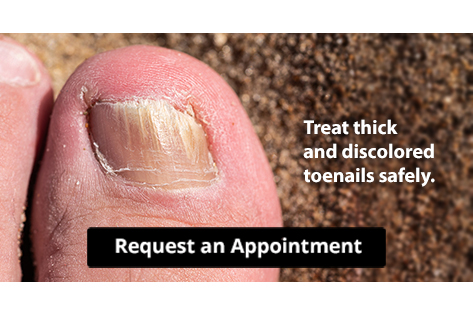Blog
Preventing Falls at Home
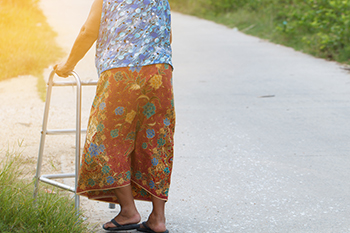
Falls at home are a common risk, particularly for older people. Making simple changes can prevent them and ensure safety. For floors, stairways, and hallways, it is important to use handrails, good lighting, and non-slip strips. Additionally, it is beneficial to avoid using throw rugs and refrain from walking on wet floors. In bathrooms, install grab bars and use non-skid bath mats. It is helpful to keep night lights on, in addition to having a flashlight near the bed. Organize the kitchen for easy access and clean up spills immediately. Fix broken steps, and keep pathways clear on the outside of the home. In other living areas, keep cords away, arrange furniture wisely, and have essential items within reach. Avoid using chairs or tables to reach high objects. Have emergency numbers accessible and consider immediate response systems for extra protection. If you would like to learn more about falls prevention, it is suggested that you make an appointment with a podiatrist to discuss this topic further.
Preventing falls among the elderly is very important. If you are older and have fallen or fear that you are prone to falling, consult with Richard P. Jacoby, DPM from Extremity Health Centers. Our doctor will assess your condition and provide you with quality advice and care.
Every 11 seconds, an elderly American is being treated in an emergency room for a fall related injury. Falls are the leading cause of head and hip injuries for those 65 and older. Due to decreases in strength, balance, senses, and lack of awareness, elderly persons are very susceptible to falling. Thankfully, there are a number of things older persons can do to prevent falls.
How to Prevent Falls
Some effective methods that older persons can do to prevent falls include:
- Enrolling in strength and balance exercise program to increase balance and strength
- Periodically having your sight and hearing checked
- Discuss any medications you have with a doctor to see if it increases the risk of falling
- Clearing the house of falling hazards and installing devices like grab bars and railings
- Utilizing a walker or cane
- Wearing shoes that provide good support and cushioning
- Talking to family members about falling and increasing awareness
Falling can be a traumatic and embarrassing experience for elderly persons; this can make them less willing to leave the house, and less willing to talk to someone about their fears of falling. Doing such things, however, will increase the likelihood of tripping or losing one’s balance. Knowing the causes of falling and how to prevent them is the best way to mitigate the risk of serious injury.
If you have any questions, please feel free to contact one of our offices located in Scottsdale and Buckeye, AZ . We offer the newest diagnostic and treatment technologies for all your foot care needs.
Types and Common Causes of Ingrown Toenails
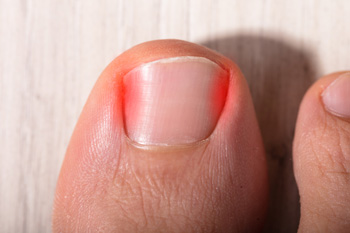
Ingrown toenails can cause immense discomfort and frustration. Understanding the different types and underlying causes can help prevent and address this uncomfortable foot condition. The edge of a toenail that grows into the surrounding skin is referred to as a distal ingrown toenail and is considered to be the most common type. When the nail grows into either side of the skin, this is known as a lateral ingrown toenail. Common symptoms can include redness, swelling, and it may become infected. If the toenail is not trimmed properly, it may result in a portion of the nail penetrating the skin, which is known as a partial ingrown toenail. People who wear shoes that do not fit correctly, in addition to those with a foot injury, may find they have developed an ingrown toenail. If you have this foot condition, it is strongly suggested that you consult with a podiatrist who can offer you treatment options that may include minor surgery for partial removal.
Ingrown toenails may initially present themselves as a minor discomfort, but they may progress into an infection in the skin without proper treatment. For more information about ingrown toenails, contact Richard P. Jacoby, DPM of Extremity Health Centers. Our doctor can provide the care you need to keep you pain-free and on your feet.
Ingrown Toenails
Ingrown toenails are caused when the corner or side of a toenail grows into the soft flesh surrounding it. They often result in redness, swelling, pain, and in some cases, infection. This condition typically affects the big toe and may recur if it is not treated properly.
Causes
- Improper toenail trimming
- Genetics
- Improper shoe fitting
- Injury from pedicures or nail picking
- Abnormal gait
- Poor hygiene
You are more likely to develop an ingrown toenail if you are obese, have diabetes, arthritis, or have any fungal infection in your nails. Additionally, people who have foot or toe deformities are at a higher risk of developing an ingrown toenail.
Symptoms
Some symptoms of ingrown toenails are redness, swelling, and pain. In rare cases, there may be a yellowish drainage coming from the nail.
Treatment
Ignoring an ingrown toenail can have serious complications. Infections of the nail border can progress to a deeper soft-tissue infection, which can then turn into a bone infection. You should always speak with your podiatrist if you suspect you have an ingrown toenail, especially if you have diabetes or poor circulation.
If you have any questions, please feel free to contact one of our offices located in Scottsdale and Buckeye, AZ . We offer the newest diagnostic and treatment technologies for all your foot care needs.
Why Do I Have Foot Pain?

Research has shown that approximately 20 percent of adults have foot pain regularly. There are various reasons why this can happen, including the wear and tear that can come from being obese. Stress fractures are a common source of foot pain among physically active people. This can happen from repetitive motion while frequently running or jogging, and the number of cases may have increased during the pandemic. Plantar fasciitis can begin with heel pain and often becomes worse without medical treatment. Diabetic patients experience foot pain which may be due to the nerve damage that often accompanies this condition. Psoriatic arthritis may begin with foot pain, and the ankle joints can become inflamed, too. If you have any type of foot pain, it is strongly suggested that you are under the care of a podiatrist who can effectively diagnose and treat foot pain conditions.
Foot Pain
Foot pain can be extremely painful and debilitating. If you have a foot pain, consult with Richard P. Jacoby, DPM from Extremity Health Centers. Our doctor will assess your condition and provide you with quality foot and ankle treatment.
Causes
Foot pain is a very broad condition that could be caused by one or more ailments. The most common include:
- Bunions
- Hammertoes
- Plantar Fasciitis
- Bone Spurs
- Corns
- Tarsal Tunnel Syndrome
- Ingrown Toenails
- Arthritis (such as Gout, Rheumatoid, and Osteoarthritis)
- Flat Feet
- Injury (from stress fractures, broken toe, foot, ankle, Achilles tendon ruptures, and sprains)
- And more
Diagnosis
To figure out the cause of foot pain, podiatrists utilize several different methods. This can range from simple visual inspections and sensation tests to X-rays and MRI scans. Prior medical history, family medical history, and any recent physical traumatic events will all be taken into consideration for a proper diagnosis.
Treatment
Treatment depends upon the cause of the foot pain. Whether it is resting, staying off the foot, or having surgery; podiatrists have a number of treatment options available for foot pain.
If you have any questions, please feel free to contact one of our offices located in Scottsdale and Buckeye, AZ . We offer the newest diagnostic and treatment technologies for all your foot care needs.
Stop Your Toenail Fungus
Causes of Big Toe Joint Pain

Big toe joint pain can be caused by various conditions, like arthritis, bunions, gout, sesamoiditis, or turf toe. These conditions can lead to stiffness, swelling, and a grinding sensation. Even though the toe joints are small, they support a significant amount of body weight and play a crucial role in foot function. The most common form of arthritis affecting the big toe is osteoarthritis, which results from tissue erosion between bones and joints. It makes it difficult to straighten the toe and causes pain while standing or walking. Bone spurs can also develop on the top of the big toe, leading to pain, particularly when wearing shoes. Bunions, characterized by a large bump on the joint of the big toe, are deformities that cause the toe to shift towards the smaller toes. They can be caused by things such as genetics, tight shoes, or rheumatoid arthritis. Finding comfortable shoes becomes challenging, and wearing them can be painful. Bunions result in redness, irritation, and swelling on the side of the big toe. Gout, another type of arthritis, occurs when uric acid builds up in the blood, forming crystals that deposit into a joint, often affecting the big toe joint. Uric acid is a waste product that accumulates when purines, found in certain foods like red meat, seafood, and alcohol, are broken down. Failure to eliminate uric acid through the kidneys can lead to gout, causing intense pain, swelling, redness, and heat in the joint. Since big toe pain can have various causes, it is suggested that you consult a podiatrist for an examination, a diagnosis, and the appropriate treatment options.
Toe pain can disrupt your daily activities. If you have any concerns, contact Richard P. Jacoby, DPM of Extremity Health Centers. Our doctor can provide the care you need to keep you pain-free and on your feet.
What Causes Toe Pain?
Most severe toe pain is caused due to a sports injury, trauma from dropping something heavy on the toe, or bumping into something rigid. Other problems can develop over time for various reasons.
Toe pain can be caused by one or more ailments. The most common include:
- Trauma
- Sports injury
- Wearing shoes that are too tight
- Arthritis
- Gout
- Corns and calluses
- Hammertoe
- Bunions
- Blisters
- Ingrown toenails
- Sprains
- Fractures (broken bones)
- Dislocations
When to See a Podiatrist
- Severe pain
- Persistent pain that lasts more than a week
- Signs of infection
- Continued swelling
- Pain that prevents walking
Diagnosis
In many cases the cause of toe pain is obvious, but in others, a podiatrist may want to use more advanced methods to determine the problem. These can range from simple visual inspections and sensation tests to X-rays and MRI scans. Prior medical history, family medical history, and any recent physical traumatic events will all be taken into consideration for a proper diagnosis.
Treatment
Treatments for toe pain and injuries vary and may include shoe inserts, padding, taping, medicines, injections, and in some cases, surgery. If you believe that you have broken a toe, please see a podiatrist as soon as possible.
If you have any questions please feel free to contact one of our offices located in Scottsdale and Buckeye, AZ . We offer the newest diagnostic tools and technology to treat your foot and ankle needs.
Why Your Feet May Smell Bad
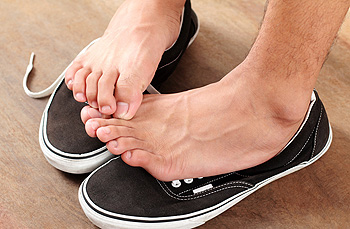
When a distinct foul odor emanates from your shoes or feet, it can be an indication of an infection. Bacteria thrive in warm, moist atmospheres, such as the inside of a shoe or between the toes. Two types of bacteria are common causes of foot odor as they interact with the sweat on the feet and produce chemicals that smell bad. Isovaleric acid emanates a cheesy, sweaty foot odor, while propionic acid projects a sour smell. In addition, brevibacteria, which eats the dead skin on the toes, can produce a gas that also smells sour. Socks and shoes that don’t allow sweat to evaporate from the skin can be another cause of foot odor. A fungal infection, or tinea, frequently termed athlete’s foot, can also result in foot odor. The first line of defense against smelly feet is developing a daily foot care and hygiene regime. Wash and dry the feet thoroughly, especially between the toes. Allow your shoes and socks to dry completely between wearings. If foot odor is an ongoing problem for you, it is suggested that you make an appointment with a podiatrist for an evaluation and possible treatment options.
Everyday foot care is very important to prevent infection and other foot ailments. If you need your feet checked, contact Richard P. Jacoby, DPM from Extremity Health Centers. Our doctor can provide the care you need to keep you pain-free and on your feet.
Everyday Foot Care
Often, people take care of their bodies, face and hair more so than they do for their feet. But the feet are a very important aspect of our bodies, and one that we should pay more attention to. Without our feet, we would not be able to perform most daily tasks.
It is best to check your feet regularly to make sure there are no new bruises or cuts that you may not have noticed before. For dry feet, moisturizer can easily be a remedy and can be applied as often as necessary to the affected areas. Wearing shoes that fit well can also help you maintain good foot health, as well as making it easier to walk and do daily activities without the stress or pain of ill-fitting shoes, high heels, or even flip flops. Wearing clean socks with closed shoes is important to ensure that sweat and bacteria do not accumulate within the shoe. Clean socks help to prevent Athlete’s foot, fungi problems, bad odors, and can absorb sweat.
If you have any questions please feel free to contact one of our offices located in Scottsdale and Buckeye, AZ . We offer the newest diagnostic and treatment technologies for all your foot and ankle needs.
The Definition of a Bunion
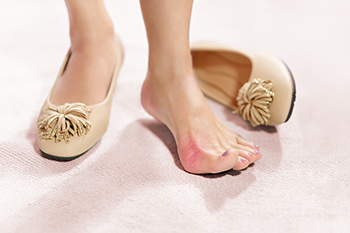
A bunion is a progressive bone disorder and is considered to be a deformity. It is defined as a bony lump that develops on the side of the big toe and may change the structure of the foot. Severe bunions may cause the other toes to shift toward each other, and larger shoes may need to be purchased. A common reason why people get bunions can be from the shoes that are worn. If the shoe does not have adequate room for toes to move freely in, they may gradually become cramped, and a small bump may be noticeable. Bunions may also happen from genetic reasons, or possibly from having flat feet or low arches. Temporary relief may be found when a protective pad is placed over the bunion, in addition to wearing shoes that fit correctly. If you have developed a bunion, it is suggested that you visit a podiatrist who can provide a more permanent solution, which may include surgery for removal.
If you are suffering from bunions, contact Richard P. Jacoby, DPM of Extremity Health Centers. Our doctor can provide the care you need to keep you pain-free and on your feet.
What Is a Bunion?
A bunion is formed of swollen tissue or an enlargement of boney growth, usually located at the base joint of the toe that connects to the foot. The swelling occurs due to the bones in the big toe shifting inward, which impacts the other toes of the foot. This causes the area around the base of the big toe to become inflamed and painful.
Why Do Bunions Form?
Genetics – Susceptibility to bunions are often hereditary
Stress on the feet – Poorly fitted and uncomfortable footwear that places stress on feet, such as heels, can worsen existing bunions
How Are Bunions Diagnosed?
Doctors often perform two tests – blood tests and x-rays – when trying to diagnose bunions, especially in the early stages of development. Blood tests help determine if the foot pain is being caused by something else, such as arthritis, while x-rays provide a clear picture of your bone structure to your doctor.
How Are Bunions Treated?
- Refrain from wearing heels or similar shoes that cause discomfort
- Select wider shoes that can provide more comfort and reduce pain
- Anti-inflammatory and pain management drugs
- Orthotics or foot inserts
- Surgery
If you have any questions, please feel free to contact one of our offices located in Scottsdale and Buckeye, AZ . We offer the newest diagnostic and treatment technologies for all your foot care needs.
How Household Changes Can Help to Prevent Falling
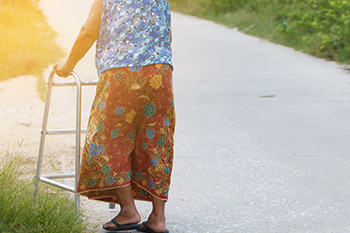
Research has shown that approximately 25 percent of adults fall every year. Many of these people can experience consequences that can range from breaking a bone to the inability to complete daily activities as a result of having a fear of falling. Falling can happen from having an unsafe living environment, existing medical conditions, or a change in eyesight. There are simple methods that can be implemented which can help to reduce the number of falls. Installing grab bars in the toilet and shower area and using a non-skid bathmat are effective fall prevention techniques. Additionally, removing worn rugs and improving lighting in the household can make the home safer. Many elderly people choose to stretch and exercise daily, which is helpful in keeping the body strong, and possibly helping to prevent falling. If you would like additional knowledge about how falling can affect the feet and how to avoid this, it is suggested that you confer with a podiatrist who can offer you useful tips.
Preventing falls among the elderly is very important. If you are older and have fallen or fear that you are prone to falling, consult with Richard P. Jacoby, DPM from Extremity Health Centers. Our doctor will assess your condition and provide you with quality advice and care.
Every 11 seconds, an elderly American is being treated in an emergency room for a fall related injury. Falls are the leading cause of head and hip injuries for those 65 and older. Due to decreases in strength, balance, senses, and lack of awareness, elderly persons are very susceptible to falling. Thankfully, there are a number of things older persons can do to prevent falls.
How to Prevent Falls
Some effective methods that older persons can do to prevent falls include:
- Enrolling in strength and balance exercise program to increase balance and strength
- Periodically having your sight and hearing checked
- Discuss any medications you have with a doctor to see if it increases the risk of falling
- Clearing the house of falling hazards and installing devices like grab bars and railings
- Utilizing a walker or cane
- Wearing shoes that provide good support and cushioning
- Talking to family members about falling and increasing awareness
Falling can be a traumatic and embarrassing experience for elderly persons; this can make them less willing to leave the house, and less willing to talk to someone about their fears of falling. Doing such things, however, will increase the likelihood of tripping or losing one’s balance. Knowing the causes of falling and how to prevent them is the best way to mitigate the risk of serious injury.
If you have any questions, please feel free to contact one of our offices located in Scottsdale and Buckeye, AZ . We offer the newest diagnostic and treatment technologies for all your foot care needs.
Foot Ulcers Can Be a Serious Condition

A foot ulcer is a serious wound. It is said to look like a crater in the skin and is generally found on the bottom of the foot or tip of a toe. Thick skin can gradually surround it and may act like a border. A foot ulcer can be common among diabetic patients, and immediate wound care is often sought for treatment and relief. A foot ulcer can range between being a surface wound to a deep wound, and both types can become infected if not treated. Diabetic patients can suffer from neuropathy, which is the inability to feel sensations on the feet. This may also be coupled with poor circulation, which may slow down the healing process. A foot ulcer that develops in people who have good circulation may heal in approximately six weeks, but it may take considerably longer in patients who have poor circulation. Treatment can begin with a podiatrist performing a debridement, which is trimming away diseased tissue. This can be followed by applying an appropriate dressing and recommending specialized footwear. If you have a foot ulcer, it is strongly suggested that you are under the care of a podiatrist who can successfully treat this foot condition.
Wound care is an important part in dealing with diabetes. If you have diabetes and a foot wound or would like more information about wound care for diabetics, consult with Richard P. Jacoby, DPM from Extremity Health Centers. Our doctor will assess your condition and provide you with quality foot and ankle treatment.
What Is Wound Care?
Wound care is the practice of taking proper care of a wound. This can range from the smallest to the largest of wounds. While everyone can benefit from proper wound care, it is much more important for diabetics. Diabetics often suffer from poor blood circulation which causes wounds to heal much slower than they would in a non-diabetic.
What Is the Importance of Wound Care?
While it may not seem apparent with small ulcers on the foot, for diabetics, any size ulcer can become infected. Diabetics often also suffer from neuropathy, or nerve loss. This means they might not even feel when they have an ulcer on their foot. If the wound becomes severely infected, amputation may be necessary. Therefore, it is of the upmost importance to properly care for any and all foot wounds.
How to Care for Wounds
The best way to care for foot wounds is to prevent them. For diabetics, this means daily inspections of the feet for any signs of abnormalities or ulcers. It is also recommended to see a podiatrist several times a year for a foot inspection. If you do have an ulcer, run the wound under water to clear dirt from the wound; then apply antibiotic ointment to the wound and cover with a bandage. Bandages should be changed daily and keeping pressure off the wound is smart. It is advised to see a podiatrist, who can keep an eye on it.
If you have any questions, please feel free to contact one of our offices located in Scottsdale and Buckeye, AZ . We offer the newest diagnostic and treatment technologies for all your foot care needs.
Why Live with Pain and Numbness in Your Feet?
More...
Dealing With Flat Feet
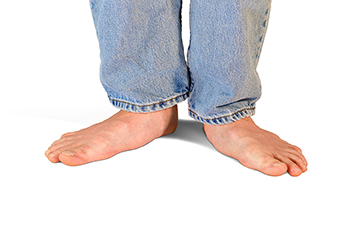
Flat feet, also termed pes planus, is a condition where the arch of the foot collapses and the bottom of the foot lies flat on the ground. Three common types of flat feet are flexible, rigid, and adult-onset. Flexible flat feet are the most common, where the arch is visible while sitting, but disappears when weight is taken off of the foot. It affects both feet and gradually worsens with age. With rigid flat feet, the foot arch is missing in all conditions. The feet may become painful and it may be difficult to flex the foot or even move it from side to side. This may affect one or both feet. Adult-acquired, or fallen arches, occurs when the arch suddenly collapses. This problem commonly affects only one foot, and is frequently the result of an injury to the tendon that supports the arch. Certain conditions can bring on the occurrence of flat feet, including Achilles tendon injuries, broken bones, obesity, and pregnancy. To manage flat feet, it is suggested that you consult a podiatrist who can determine the cause and offer treatment options.
Flatfoot is a condition many people suffer from. If you have flat feet, contact Richard P. Jacoby, DPM from Extremity Health Centers. Our doctor will treat your foot and ankle needs.
What Are Flat Feet?
Flatfoot is a condition in which the arch of the foot is depressed and the sole of the foot is almost completely in contact with the ground. About 20-30% of the population generally has flat feet because their arches never formed during growth.
Conditions & Problems:
Having flat feet makes it difficult to run or walk because of the stress placed on the ankles.
Alignment – The general alignment of your legs can be disrupted, because the ankles move inward which can cause major discomfort.
Knees – If you have complications with your knees, flat feet can be a contributor to arthritis in that area.
Symptoms
- Pain around the heel or arch area
- Trouble standing on the tip toe
- Swelling around the inside of the ankle
- Flat look to one or both feet
- Having your shoes feel uneven when worn
Treatment
If you are experiencing pain and stress on the foot you may weaken the posterior tibial tendon, which runs around the inside of the ankle.
If you have any questions please feel free to contact one of our offices located in Scottsdale and Buckeye, AZ . We offer the newest diagnostic and treatment technologies for all your foot and ankle needs.
What Is Cuboid Syndrome?

Cuboid syndrome involves lateral foot and ankle pain and is a disruption of the calcaneocuboid part of the midtarsal joint, which irritates the surrounding areas. The foot is made up of 26 bones, and the cuboid bone provides stability to the foot. This syndrome is thought to be from overuse, plantar flexion difficulties, and inversion ankle sprains. Athletes with foot injuries, particularly ballet dancers, can develop cuboid syndrome. Orthotics that are not constructed properly and heel spur surgery can also trigger the symptoms of this syndrome Because radiographic imaging does not detect this syndrome, it can be difficult to recognize, and can easily be misdiagnosed and mistreated. A diagnosis is based on history and symptoms. However, once properly diagnosed, it can respond well to conservative treatment that involves manipulation of the cuboid bone, exercises, and taping. If you have lateral foot and ankle pain that is persistent, it is suggested that you schedule an appointment with a podiatrist for a proper diagnosis and treatment.
Cuboid syndrome, also known as cuboid subluxation, occurs when the joints and ligaments near the cuboid bone in the foot become torn. If you have cuboid syndrome, consult with Richard P. Jacoby, DPM from Extremity Health Centers. Our doctor will assess your condition and provide you with quality foot and ankle treatment.
Cuboid syndrome is a common cause of lateral foot pain, which is pain on the outside of the foot. The condition may happen suddenly due to an ankle sprain, or it may develop slowly overtime from repetitive tension through the bone and surrounding structures.
Causes
The most common causes of cuboid syndrome include:
- Injury – The most common cause of this ailment is an ankle sprain.
- Repetitive Strain – Tension placed through the peroneus longus muscle from repetitive activities such as jumping and running may cause excessive traction on the bone causing it to sublux.
- Altered Foot Biomechanics – Most people suffering from cuboid subluxation have flat feet.
Symptoms
A common symptom of cuboid syndrome is pain along the outside of the foot which can be felt in the ankle and toes. This pain may create walking difficulties and may cause those with the condition to walk with a limp.
Diagnosis
Diagnosis of cuboid syndrome is often difficult, and it is often misdiagnosed. X-rays, MRIs and CT scans often fail to properly show the cuboid subluxation. Although there isn’t a specific test used to diagnose cuboid syndrome, your podiatrist will usually check if pain is felt while pressing firmly on the cuboid bone of your foot.
Treatment
Just as the range of causes varies widely, so do treatments. Some more common treatments are ice therapy, rest, exercise, taping, and orthotics.
If you have any questions, please feel free to contact one of our offices located in Scottsdale and Buckeye, AZ . We offer the newest diagnostic and treatment technologies for all your foot care needs.
Diabetes and Limb Salvage

Limb salvage can be done to preserve function when diabetics have chronic ulceration. Chronic ulcerations of the feet can occur due to an abnormal gait, surgical incisions that do not heal or take a long time to heal, and from wounds on the feet that have not been treated. Sometimes joint immobility in a person with diabetes can lead to bony prominences on the sole of the foot, which will often cause ulcerations. A stiff foot can cause pressure to be applied in a diabetic foot which will also lead to ulcerations. If you have diabetes and problems with your feet or ankles, it is strongly suggested that you have a podiatrist on your roster of doctors. This medical professional can examine your feet regularly and help you to prevent and treat chronic and serious issues, such as ulcerations requiring limb salvage that may occur as the result of diabetes.
Limb salvage can be an effective way in preventing the need for limb amputation. If you have diabetes, cancer, or any other condition that could lead to foot amputation if left unchecked, consult with Richard P. Jacoby, DPM from Extremity Health Centers. Our doctor will assess your condition and provide you with quality foot and ankle treatment.
What Is Limb Salvage?
Limb salvage is the attempt of saving a limb, such as the foot from amputation. Podiatrists also try to make sure that there is enough function in the foot after the salvage that it is still usable. Diabetes is the number one cause of non-traumatic amputations in the United States. Those with diabetes experience poor blood circulation, which prevents proper healing of an ulcer. If the ulcer is left uncheck, it could become infected, which could result in the need for amputation.
However, there are other causes as well, such as cancer and traumatic injury. Links between higher mortality rates and amputation have been found. This translates into higher healthcare costs, and a reduced quality of life and mobility for amputees. Podiatrists have attempted to increase the prevalence of limb salvage in an attempt to solve these issues.
Diagnosis and Treatment
Limb salvage teams have grown in recent years that utilize a number of different treatments to save the infected limb. This includes podiatrists that specialize in wound care, rehabilitation, orthotics, and surgery. Through a combination of these methods, limb salvage has been found to be an effective treatment for infected limbs, and as an alternative to amputation. Podiatrists will first evaluate the potential for limb salvage and determine if the limb can be saved or must be amputated.
If you have any questions, please feel free to contact one of our offices located in Scottsdale and Buckeye, AZ . We offer the newest diagnostic and treatment technologies for all your foot care needs.
Symptoms of a Heel Spur
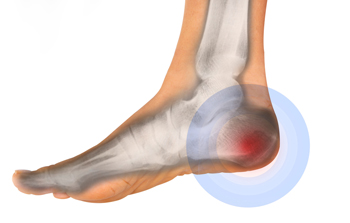
There are some people who have heel pain, and it may be caused by a heel spur. It is defined as a bony growth that forms on the bottom of the heel bone, and it can feel like a thorn in the foot. It generally forms at the point where the Achilles tendon connects to the back of the heel bone. A heel spur can happen from putting excessive strain on the foot. It can measure up to a half inch in length, and can become inflamed. Having an X-ray taken can be successful in determining if a heel spur exists. This is often performed after confirming symptoms, which may include increased pain while walking and avoiding any weight on the heel. Many patients walk on their tiptoes and find their pain is reduced while sitting down. Additionally, it may hurt when it is pressed on, and these symptoms may indicate medical attention is needed for relief. If you have heel pain, it is suggested that you speak with a podiatrist who can confirm a heel spur diagnosis and offer correct treatment solutions.
Heel spurs can be incredibly painful and sometimes may make you unable to participate in physical activities. To get medical care for your heel spurs, contact Richard P. Jacoby, DPM from Extremity Health Centers. Our doctor will do everything possible to treat your condition.
Heels Spurs
Heel spurs are formed by calcium deposits on the back of the foot where the heel is. This can also be caused by small fragments of bone breaking off one section of the foot, attaching onto the back of the foot. Heel spurs can also be bone growth on the back of the foot and may grow in the direction of the arch of the foot.
Older individuals usually suffer from heel spurs and pain sometimes intensifies with age. One of the main condition's spurs are related to is plantar fasciitis.
Pain
The pain associated with spurs is often because of weight placed on the feet. When someone is walking, their entire weight is concentrated on the feet. Bone spurs then have the tendency to affect other bones and tissues around the foot. As the pain continues, the feet will become tender and sensitive over time.
Treatments
There are many ways to treat heel spurs. If one is suffering from heel spurs in conjunction with pain, there are several methods for healing. Medication, surgery, and herbal care are some options.
If you have any questions feel free to contact one of our offices located in Scottsdale and Buckeye, AZ . We offer the latest in diagnostic and treatment technology to meet your needs.
